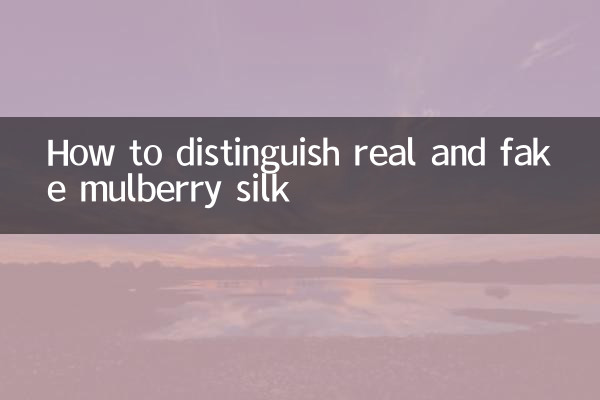How to distinguish real and fake mulberry silk? Popular topics and practical guides on the Internet in the past 10 days
Recently, with the arrival of summer, mulberry silk products have become a hot consumer topic, but the issue of difficulty in distinguishing authenticity from fake products in the market has also triggered widespread discussion. Many netizens shared their experiences of "falling into traps" when purchasing mulberry silk quilts and clothing, and "how to identify true and false mulberry silk" has become one of the keywords with soaring search volume in the past 10 days. This article combines the hot discussions on the Internet to compile a structured data guide to help you easily avoid fake and inferior products.
1. The core difference between real and fake mulberry silk

There are essential differences between mulberry silk (real silk) and chemical fiber imitation silk in terms of material, touch, and combustion reaction. The following is the comparative data that is hotly discussed across the Internet:
| Comparative item | Real mulberry silk | Chemical fiber imitation silk |
|---|---|---|
| Glossiness | Soft and natural, with pearl-like luster | Dazzling reflection and strong plastic feel |
| touch | Delicate and smooth, cool but not icy | Rough or static |
| Burn test | Slow burning rate, smell of burning hair, ash is brittle | Burns quickly, has a plastic smell, and has hard ash. |
| price range | 100% mulberry silk quilt ≥500 yuan/jin | Usually less than 200 yuan/jin |
2. Four identification methods that are hotly discussed on the Internet
1."Look at the label" method: Nearly 30% of netizens mentioned that they need to look for “100% mulberry silk” or “Grade A silk” labels when purchasing, and be wary of vague expressions such as “mixed silk” and “tussah silk”.
2.“84 Disinfectant” Test: Real silk will dissolve when exposed to 84 disinfectant (protein reaction), while chemical fiber will remain unchanged. This method has been liked more than 100,000 times on social platforms, but please be aware of its destructive nature.
3."Friction listening" method: Rubbing the silk hard will produce a crisp "silk sound", which is silent or muffled like silk. The cumulative views of Douyin-related videos exceeded 100 million.
4."Microscopic Observation" Method: A professional blogger showed through microscope comparison that silk fibers are uneven in thickness and have triangular cross-sections, while chemical fibers are neat and smooth.
3. Consumers often step on pitfalls
According to the complaint data of the e-commerce platform in the past 10 days, the problem of fake mulberry silk mainly occurs in the following scenarios:
| Trap type | Proportion | Typical cases |
|---|---|---|
| "Silk quilt" | 45% | Outer layer of silk + inner layer of chemical fiber |
| "low price promotion" | 30% | 99 yuan "real silk" scarf in the live broadcast room |
| "False test report" | 15% | PS fake certificate |
4. Authoritative purchasing advice
1.Look for big brands: The authenticity rate of Luolai, Ciyun and other brands exceeds 98% (data source: China Silk Association).
2.Ask for a test port: Require merchants to provide CMA certified test reports, focusing on the "fiber content" column.
3.Keep evidence of rights protection: Take an unboxing video and save a screenshot of the product page so you can appeal if you find any problems.
As a natural protein fiber, mulberry silk has irreplaceable skin-friendliness and breathability. By mastering these identification skills, you can easily avoid consumption traps and enjoy a truly silky smooth experience like the “anti-counterfeiting expert” that is the hot topic on the Internet!

check the details

check the details